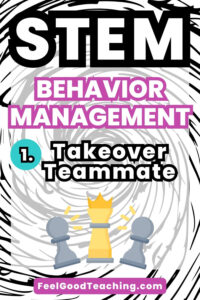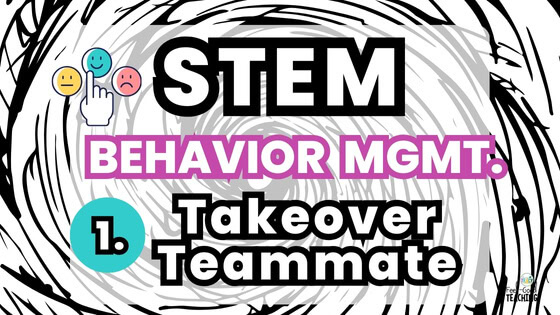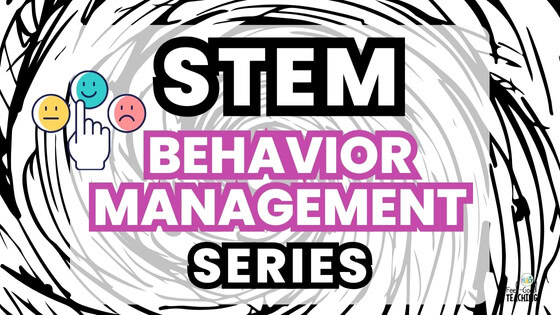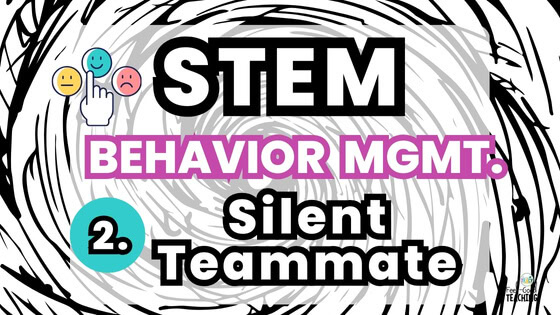Welcome to the STEM Classroom Management Blog Series! Managing a STEM classroom comes with a unique set of joys and challenges. In this blog series, we’re digging into the real-life scenarios that pop up during STEM challenges, especially during collaborative group work.
Whether you’re dealing with off-task teams, reluctant contributors, or students who want to run the show, you’ll find teacher-tested strategies for building teamwork, critical thinking, communication, and creativity.
Today we’re tackling one of the most common scenarios: The Takeover Teammate.
Meet the Takeover Teammate
You know the one. You give your students a STEM challenge and within two minutes:
- One student has taken every material,
- Started building solo,
- And is “delegating” tasks to the rest of the group without listening to anyone else’s ideas.
Meanwhile, the rest of the team is disengaged or frustrated. Some are feeling left out, others silently giving up.
This isn’t just a personality quirk. It’s a STEM classroom management issue that impacts learning for the whole team. But with the right approach, it’s also a powerful teaching opportunity.
Why Do Takeover Teammates Dominate Group Work?
Takeover behavior doesn’t usually come from a bad place. Here are a few common reasons behind it:
1. They’re used to being “the responsible one.”
Especially in early grades, high-achieving students may feel pressure to “get it done” and assume others won’t pull their weight.
2. They’re anxious about success.
If your classroom uses competition, time pressure, or public testing, some students may take control out of fear of failing.
3. They’ve never been taught what true collaboration looks like.
We say “work together,” but do we actually show what that means? Without modeling and practice, students fall back on what they know.
4. They’re unaware of their impact.
Many students don’t realize they’re dominating. They assume everyone’s okay with it unless someone speaks up, which rarely happens.
Strategies for Supporting the Takeover Teammate (Without Singling Them Out)
Let’s talk about what to do before, during, and after the challenge to create a more balanced group dynamic.
🌍 Before the Challenge: Set the Stage for Equity
Teach teamwork like any other skill. Before assigning a group task, explicitly teach what collaboration looks and sounds like. I recommend using a reflection tool like the Collaboration Freebie Lesson or the 4 Cs Posters & Reflection Pages to co-create class norms for:
- Respectful sharing of ideas
- Turn-taking
- Giving and receiving feedback
The Role of Roles. Personally, I’ve found assigning roles to cause more problems for me than it solves (e.g. Builder, Materials Manager, Recorder, Reporter, etc.). So if you’ve been encountering problems using them, try skipping the assigned roles to see if that helps students come to a more organic way of collaborating.
Or if you haven’t used roles, give it a try to see if that mitigates your takeover teammate issues. Just be sure if you do assign roles that you rotate the roles every challenge so everyone practices different skills.
Use a “one idea per person” rule. Require each student to contribute at least one idea before the team finalizes a plan. This guarantees space for every voice.
⏱️ During the Challenge: Intervene Gently, Prompt Reflectively
Use neutral, non-judgmental language.
“I noticed one person doing most of the building. Is everyone getting a chance to contribute?”
This shifts the group dynamic without calling anyone out.
Privately check in with the dominant student. Pull them aside and say:
“I can see you’re really invested in the build. What do you think your team might miss out on if they don’t get to share their ideas?”
Encourage design blending. If two students have different ideas, challenge them to combine the best features of both. Ask:
“What’s one strong element from each design?”
Time-box turns. Give each student a 2-minute turn to speak, sketch, or build. This helps regulate time hoarding.
Collaboration Spies. On your next challenge, pull your takeover teammates and other students who may benefit and assign them a very special role: collaboration spy! Set them up with clipboards and instructions to be careful, silent observers looking for good & bad examples of collaboration. Cycle them through every group so when they report back, no one is identifiable.
Give the spies time to report to the class on what they saw that went well and didn’t in the groups they observed (without naming names, of course). This can become an option at any point as a refresher or an opportunity for any student who needs to skip a build day.
🔄 After the Challenge: Reflect, Don’t Just Redirect
Use a 4 Cs self-assessment rubric. After the challenge, give students time to reflect on their collaboration. Have them rate how well they:
- Shared responsibilities
- Respected teammates
- Listened and responded to others
Prompt whole-class discussion.
- What did strong collaboration look like today?
- How did it feel when someone else ran the show?
- What would we do differently next time?
Celebrate improvements. If your takeover teammate adjusts their behavior, even slightly, recognize it!
“I noticed you paused to let your partner share their idea today. That showed a lot of growth in your teamwork.”
🔄 Turn the Challenge Into a Teaching Tool
When handled thoughtfully, a takeover teammate moment becomes a great opportunity to:
- Introduce or revisit collaboration norms
- Give quieter students a voice
- Help high-achievers develop empathy and leadership
STEM challenges are the perfect playground for practicing real-world skills. So rather than getting frustrated, use these moments as springboards for stronger teams.
💡 Want a Free STEM Classroom Management Handbook?
I’m putting together a printable copy of these strategies as well as navigating other tricky STEM behaviors perfect for keeping in your lesson planner or sharing at your next PLC or team meeting. It will be sent to every subscriber on my email list when the series is complete. Sign up below to get on the list.
Coming Up in the Series…
We’ll explore:
- What to do when students go silent during group work
- How to handle team conflict respectfully
- Ways to re-engage students who disconnect or misuse materials
Explore all posts in the STEM Classroom Management Series here.
Looking for a STEM Challenge to Practice These Skills?
Try the Apples A-head STEM Challenge or the Back to School STEM Improv Activity. Both are designed to help students flex their collaboration muscles while having fun!
For more practice on the 4 Cs of Engineering, check out this 4 Cs Resource Bundle.
Pin it. Share it. Save it. Let’s build better teams, one STEM challenge at a time. 🚀




